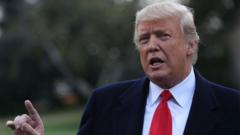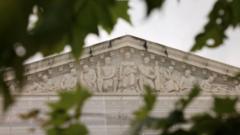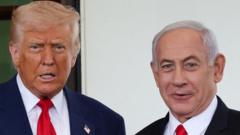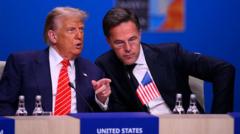The Supreme Court's recent decision has sparked discussions across sectors, indicating potential shifts in the balance of power between the executive and judicial branches. With a 6-3 ruling favoring President Trump’s stance on birthright citizenship, experts foresee increased legal scrutiny and debates on constitutional authority.
Supreme Court Limitation on Federal Judges' Authority in Trump Birthright Citizenship Saga

Supreme Court Limitation on Federal Judges' Authority in Trump Birthright Citizenship Saga
In a pivotal ruling, the Supreme Court has restricted the power of lower federal judges to issue blocks against presidential orders, impacting Trump’s controversial birthright citizenship initiative.
The top court in the US has significantly restricted the capacity of lower federal judges to intervene in presidential actions, marking a decisive win for President Donald Trump regarding his executive order on birthright citizenship. The contentious case revolved around Trump’s effort to negate birthright citizenship for children born in the US to non-citizens and undocumented immigrants through executive action.
In a ruling that split the court along ideological lines, the conservative justices comprised of a 6-3 majority decided not to directly challenge the controversial executive order itself; rather, the judgement emphasized the broader powers of the presidency. Legal experts assert that this ruling fundamentally alters the landscape of how executive interventions are questioned and obstructed in the future, and subsequent legal disputes from various organizations and states are anticipated.
The legal dispute and ensuing federal injunctions stemmed from an executive order that Trump signed upon his re-entry to the White House, aimed at rescinding birthright citizenship, a right that secures automatic citizenship for individuals born on US soil. Challenges originating from various states, including Maryland and Massachusetts, temporarily halted the enforcement of the order, leading to the Justice Department’s compelling appeal to the Supreme Court.
Following the court's ruling, which endorses the administration's position, President Trump expressed pride in the outcome during a press conference, framing it as a major victory in favor of constitutional integrity and limited judicial overreach. He criticized so-called "radical left judges" for attempting to infringe upon his executive powers, asserting that the ruling counters what he sees as a threat to democratic processes.
Attorney General Pam Bondi echoed Trump’s sentiments, stating that the ruling curtails judicial overreach in halting presidential policies. She anticipates that the Supreme Court will soon address the birthright citizenship issue specifically in its upcoming session.
Despite the ruling's favorable outcome for Trump, it comes with a caveat that courts can still intervene against presidential actions deemed unconstitutional, albeit under stricter conditions that grant presidents greater leeway. Samuel Bray, a law professor, indicated that this decision redefines the dynamic between federal courts and the executive branch, deeming that universal injunctions will no longer be effortlessly accessible in future executive action challenges.
Justice Amy Coney Barrett, who authored the majority opinion, clarified that federal courts do not hold supreme authority over the executive branch, affirming the need for courts to function within the authority bestowed upon them by Congress. Meanwhile, dissenting Justices, including Sonia Sotomayor, criticized the decision and accused the court of enabling the administration to sidestep constitutional boundaries, warning that it undermines the rule of law crucial to democracy.
With this landmark ruling, a significant chapter in the ongoing debates over immigration policy and executive power unfolds, and the conflict over Trump’s initiatives is expected to continue, with potential ramifications for future presidencies and judicial relations.
In a ruling that split the court along ideological lines, the conservative justices comprised of a 6-3 majority decided not to directly challenge the controversial executive order itself; rather, the judgement emphasized the broader powers of the presidency. Legal experts assert that this ruling fundamentally alters the landscape of how executive interventions are questioned and obstructed in the future, and subsequent legal disputes from various organizations and states are anticipated.
The legal dispute and ensuing federal injunctions stemmed from an executive order that Trump signed upon his re-entry to the White House, aimed at rescinding birthright citizenship, a right that secures automatic citizenship for individuals born on US soil. Challenges originating from various states, including Maryland and Massachusetts, temporarily halted the enforcement of the order, leading to the Justice Department’s compelling appeal to the Supreme Court.
Following the court's ruling, which endorses the administration's position, President Trump expressed pride in the outcome during a press conference, framing it as a major victory in favor of constitutional integrity and limited judicial overreach. He criticized so-called "radical left judges" for attempting to infringe upon his executive powers, asserting that the ruling counters what he sees as a threat to democratic processes.
Attorney General Pam Bondi echoed Trump’s sentiments, stating that the ruling curtails judicial overreach in halting presidential policies. She anticipates that the Supreme Court will soon address the birthright citizenship issue specifically in its upcoming session.
Despite the ruling's favorable outcome for Trump, it comes with a caveat that courts can still intervene against presidential actions deemed unconstitutional, albeit under stricter conditions that grant presidents greater leeway. Samuel Bray, a law professor, indicated that this decision redefines the dynamic between federal courts and the executive branch, deeming that universal injunctions will no longer be effortlessly accessible in future executive action challenges.
Justice Amy Coney Barrett, who authored the majority opinion, clarified that federal courts do not hold supreme authority over the executive branch, affirming the need for courts to function within the authority bestowed upon them by Congress. Meanwhile, dissenting Justices, including Sonia Sotomayor, criticized the decision and accused the court of enabling the administration to sidestep constitutional boundaries, warning that it undermines the rule of law crucial to democracy.
With this landmark ruling, a significant chapter in the ongoing debates over immigration policy and executive power unfolds, and the conflict over Trump’s initiatives is expected to continue, with potential ramifications for future presidencies and judicial relations.





















